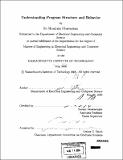Understanding program structure and behavior
Author(s)
Dharmawan, Sie Hendrata
DownloadFull printable version (31.25Mb)
Other Contributors
Massachusetts Institute of Technology. Dept. of Electrical Engineering and Computer Science.
Advisor
Saman Amarasinghe.
Terms of use
Metadata
Show full item recordAbstract
A large software system usually has structure in it. Several functions work together to accomplish a certain task, and several tasks are grouped together to perform a bigger task. In order to understand this division, one has to consult the documentations or read through the source code. However, the documentations are usually incomplete and outdated, while code inspection is tedious and impractical. Algorithms have been proposed that automatically group functions with similar functionality. In this thesis I will present LogiView, an algorithm that presents an organizational view of the functions. This view will ease the process of understanding the structures in the program, identifying functions with related tasks, and separating the functions into logical groups. I will also present a methodology of analyzing the function names in the program. This method leverages the result of the LogiView algorithm and identifies the names that are most relevant to the functionality of the program. Given a set of programs that are known to have same functionality, this method extracts the similarity in the function names and builds a dictionary of the names that are semantically related to the functionality. (cont.) The methodology also detects when two programs have similar functionality and how to measure the similarity between multiple programs. Lastly, I will show that the result of the LogiView algorithm can be used to explain program performance. The abrupt change in the program behavior and repetitions of past behaviors can be explained in terms of function calls, and these functions are identified by the LogiView algorithm.
Description
Thesis (M. Eng.)--Massachusetts Institute of Technology, Dept. of Electrical Engineering and Computer Science, 2006. Includes bibliographical references (p. 117-122).
Date issued
2006Department
Massachusetts Institute of Technology. Department of Electrical Engineering and Computer SciencePublisher
Massachusetts Institute of Technology
Keywords
Electrical Engineering and Computer Science.